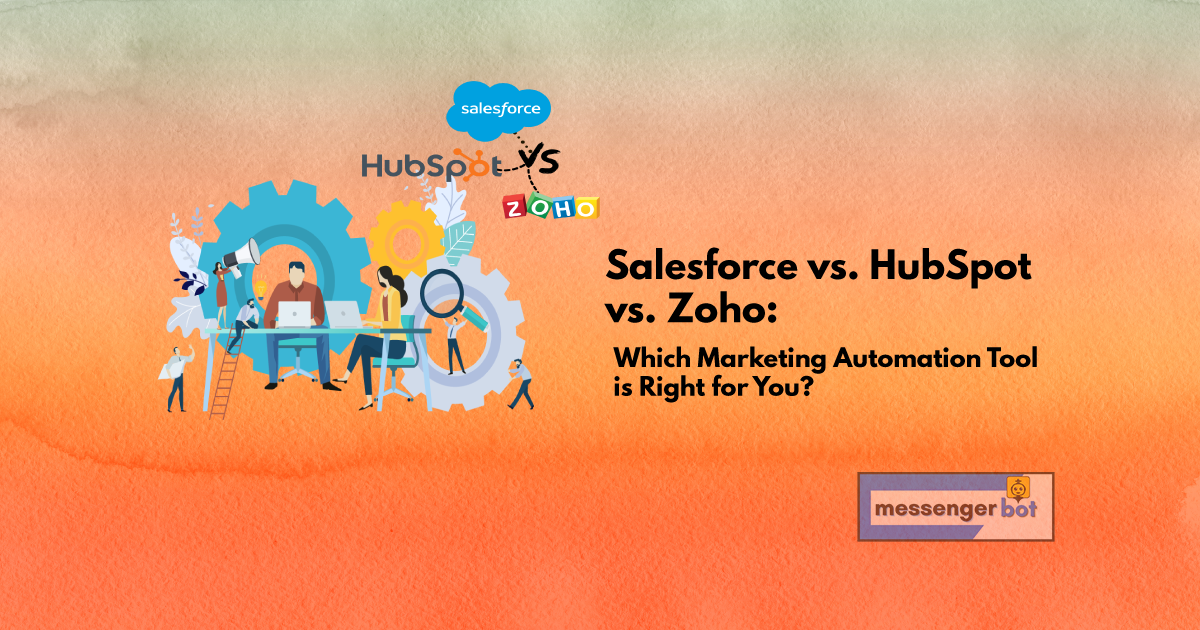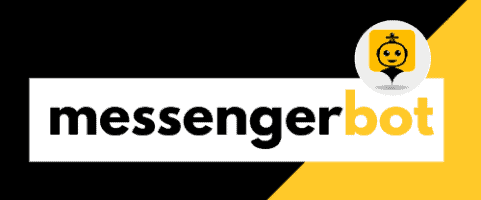Salesforce vs HubSpot vs Zoho : L'automatisation du marketing est l'une des choses les plus importantes que vous puissiez faire pour développer votre entreprise. Mais quelle plateforme d'automatisation du marketing devriez-vous utiliser ? Salesforce, HubSpot ou Zoho ?
The answer is not as simple as it seems. Each company has its advantages and disadvantages, but there are a few key points that will help you decide which tool may be best for your business.
What does CRM software do?

CRM software is designed to organize and track your company’s interactions with current and prospective customers.
CRM software is used to keep track of all your contacts and important customer information.
It can also help with managing marketing campaigns, making sales forecasts, and organizing client data.
CRM software typically has a dashboard that includes information such as leads, opportunities, contacts, and customer history.
Most CRMs have built-in contact management tools to help you keep tabs on all of your customers with details about their company, title, location, and more.
How to Decide What the Best CRM Software Is

A good CRM software should be able to give you access to all of your customer information and data in one place. It should help you manage your sales pipeline, identify key opportunities and create effective campaigns. It should also be easy to use and adaptable.
HubSpot vs Salesforce vs Zoho Features Comparison
Marketing automation tools are becoming an increasingly important part of any organization’s marketing strategy.
They offer a wide range of features to help businesses automate their marketing tasks and processes.
But which tool is right for your business?
Here’s a comparison of HubSpot, Salesforce, and Zoho – three of the most popular marketing automation tools on the market.
Team collaboration and integration

Team collaboration and integration are important to marketing because many of the tasks that are done by marketers today require more than one person. Whether it’s a designer, developer, or copywriter – using tools that allow you to collaborate with your team is extremely valuable for businesses.
Team collaboration is defined as the group effort of two or more people who work together to achieve a common goal. It is important because it helps marketers accomplish their tasks faster and easier than they would be able to if working alone.
Integration is defined as the process of incorporating one or more things into a larger system. It’s important because it allows marketers to work with and access data from other tools they may be used without having to copy and paste information which can lead to mistakes being made.
HubSpot helps teams collaborate and integrate by allowing users to share tasks with other team members. You can also add notes, files, or comments that allow multiple people to work on a project at once in real-time. In addition, HubSpot has integrations with tools such as Google Drive which allows marketers to easily create documents for their projects all from within the platform itself.
HubSpot also offers a built-in chat feature that lets team members communicate with each other in real-time. This is a great way to get quick feedback on projects or to ask for help when you need it.
Salesforce differs from HubSpot in that it offers a more closed system. With Salesforce, team members can only share tasks with other users who are also on the same account. This can be limiting for some businesses as they may want to collaborate with people outside of their company.
Salesforce also doesn’t have native integrations with other tools as HubSpot does. However, many third-party integrations are available which allow users to connect their Salesforce account with other tools they may be using.
Zoho offers a similar set of tools to HubSpot in terms of team collaboration and integration. Users can share tasks with other users who are also on the same account, add notes or files to projects, and communicate with each other via chat if needed.
Zoho is different from HubSpot because it doesn’t offer native integrations such as Google Drive (with HubSpot) or Salesforce (with HubSpot). However, third-party integrations are available which allow users to connect their Zoho account with other tools they may be using.
In terms of team collaboration and integration, HubSpot is the clear winner. Its tools make it easy for users to share tasks with other team members, add notes or files to projects, and communicate with each other in real-time. It also has integrations with many other tools which allows marketers to work with data from other sources without having to copy and paste information.
Salesforce offers similar features to HubSpot, but its system is more closed off. Team members can only share tasks with other users who are also on the same account which can be limiting for some businesses. It also doesn’t have native integrations with other tools.
Zoho offers similar features to HubSpot and Salesforce, but it doesn’t have as many integrations. Third-party integrations are available, but they do not allow users to connect their Zoho account with other tools as natively as HubSpot and Salesforce.
Reporting et analyses

Reporting and analytics are two of the most crucial elements that help you determine your marketing efforts’ success or failure. It is important to know which efforts are working and which ones aren’t so you can focus your time on the former.
Reporting and analytics are especially important for marketing automation tools because they take a lot of trial and error to get right.
HubSpot dispose de l'une des fonctionnalités de reporting les plus complètes parmi les outils d'automatisation marketing. Il propose des rapports détaillés sur les sources de trafic, les indicateurs d'engagement, l'activité sur les réseaux sociaux et les conversions.
La version gratuite vous permet de suivre jusqu'à 100 contacts à travers 20 activités différentes pour chaque prospect ou contact, y compris les visites de site web, les emails ouverts/cliqués et les appels téléphoniques passés. Les plans de la suite complète, qui commencent à $200/mois, offrent plus de fonctionnalités comme les tests A/B, les rapports personnalisés et des filtres avancés.
Salesforce ne fournit pas de reporting et d'analytique étendus car c'est principalement un outil CRM. Cependant, sa fonctionnalité de scoring des leads vous permet de suivre automatiquement le niveau d'engagement de vos prospects afin que les commerciaux soient informés si leurs prospects sont prêts à acheter ou non.
Salesforce s'intègre également à un certain nombre d'outils d'analytique tiers comme Google Analytics, Mixpanel et Tableau.
Les fonctionnalités de reporting et d'analytique de Salesforce sont beaucoup plus limitées que celles de HubSpot.
Zoho propose de nombreux rapports détaillés sur les campagnes marketing, les visiteurs du site web, les conversions de leads et les ouvertures/clics d'emails. Il offre également des tests A/B pour les emails et les pages de destination.
Cependant, il n'a pas les fonctionnalités de reporting complètes que HubSpot et Salesforce offrent. De plus, ses intégrations avec des outils d'analytique tiers se limitent à Google Analytics.
Les fonctionnalités de reporting et d'analytique de Zoho sont les plus similaires à celles de Salesforce, car il n'offre pas de rapports détaillés sur les sources de trafic, les indicateurs d'engagement ou l'activité sur les réseaux sociaux.
En termes de reporting et d'analytique, HubSpot est la meilleure option pour les outils d'automatisation marketing. Son plan gratuit offre des rapports détaillés sur les sources de trafic, les indicateurs d'engagement et l'activité sur les réseaux sociaux, tandis que ses plans de suite complète offrent des fonctionnalités supplémentaires comme les tests A/B et le reporting personnalisé. Salesforce est la meilleure option pour les outils CRM et sa fonctionnalité de scoring des leads vous permet de suivre automatiquement le niveau d'engagement de vos leads. Zoho propose de nombreux rapports détaillés sur les campagnes marketing, les visiteurs du site web, les conversions de leads et les ouvertures/clics d'emails, mais ses intégrations avec des outils d'analytique tiers sont limitées.
Évolutivité

L'évolutivité est la capacité d'un système, d'un réseau ou d'un processus à gérer une quantité de travail croissante. Les plateformes d'automatisation marketing sont des systèmes logiciels qui automatisent des tâches traditionnellement effectuées par les équipes marketing et commerciales avec des applications spéciales comme le marketing par email, les outils de gestion des réseaux sociaux, les programmes de nurturing des leads, etc. Étant donné que ces systèmes contactent des prospects au nom de votre entreprise, vous souhaitez qu'ils soient évolutifs afin de pouvoir suivre le nombre croissant de leads et de clients.
L'évolutivité est souvent considérée comme une fonction de l'architecture logicielle.
La plateforme de HubSpot est très évolutive. L'architecture de HubSpot vous permet d'ajouter un nombre illimité d'utilisateurs, de contacts et d'entreprises sans aucune dégradation des performances ou coûts supplémentaires. HubSpot peut également gérer des charges de données accrues en utilisant un système de mise en cache distribué.
L'évolutivité de HubSpot a été testée et prouvée dans le monde réel. L'entreprise a plus que doublé de taille chaque année au cours des six dernières années, et son système d'automatisation marketing a géré cette croissance sans aucun problème.
La fonctionnalité d'évolutivité de HubSpot est également constamment améliorée. HubSpot a publié l'API (Interface de Programmation d'Application) de HubSpot en 2010 pour donner aux développeurs la possibilité de créer des applications qui s'intègrent à son système d'automatisation marketing. L'entreprise a également créé une communauté de développeurs autour de son API afin que les développeurs puissent partager des astuces et des conseils pour tirer le meilleur parti de l'évolutivité de HubSpot.
Salesforce est un peu plus complexe à évoluer que HubSpot. Salesforce est conçu pour les grandes entreprises multinationales avec des milliers d'utilisateurs et de contacts. HubSpot est mieux adapté aux petites et moyennes entreprises.
Salesforce a réussi à évoluer avec succès pendant de nombreuses années. Il peut gérer les augmentations de charge en ajoutant de nouveaux serveurs ou clusters à son architecture selon les besoins.
Salesforce propose également une suite d'outils appelée Sales Cloud qui aide les équipes de vente à gérer leurs leads et clients. Le Sales Cloud est évolutif et peut gérer de grandes quantités de données.
Zoho est très simple à évoluer. Il est conçu pour les petites et moyennes entreprises qui n'ont pas beaucoup d'utilisateurs ou de contacts.
La fonctionnalité d'évolutivité de Zoho est également constamment améliorée. Chaque année, Zoho publie une nouvelle version de son logiciel avec des améliorations de performance, des corrections de bugs, des mises à jour de sécurité, etc., donc il s'améliore avec le temps sans effort supplémentaire de la part des utilisateurs.
Zoho propose une large gamme de fonctionnalités de reporting et d'analytique adaptées aux petites entreprises. L'entreprise a également réussi à évoluer avec succès pendant de nombreuses années. Elle peut gérer les augmentations de charge en ajoutant de nouveaux serveurs ou clusters à son architecture selon les besoins.
En termes d'évolutivité, HubSpot est le gagnant incontesté. Il peut gérer un nombre illimité d'utilisateurs, de contacts et d'entreprises sans aucune dégradation des performances ou coûts supplémentaires. HubSpot dispose également d'un système de mise en cache distribué qui garantit que sa plateforme peut gérer des charges de données accrues.
Salesforce est un peu plus complexe à évoluer que HubSpot, mais il peut gérer de grandes quantités de données grâce à sa suite d'outils Sales Cloud. Salesforce a également réussi à évoluer avec succès pendant de nombreuses années.
Zoho est très simple à évoluer et peut gérer les augmentations de charge en ajoutant de nouveaux serveurs ou clusters selon les besoins. La fonctionnalité d'évolutivité de Zoho est constamment améliorée chaque année avec la publication d'une nouvelle version qui inclut des corrections de bugs, des mises à jour de sécurité, etc. Zoho propose également une large gamme de fonctionnalités de reporting et d'analytique adaptées aux petites entreprises.
Tarification
Le prix est un facteur important à considérer lors du choix d'un outil d'automatisation marketing. Salesforce est l'option la plus chère, suivi de HubSpot et ensuite Zoho. Les trois ont des modèles de tarification différents, il est donc important de comprendre lequel fonctionnerait le mieux pour votre entreprise.
Le prix est défini comme le processus de décision sur la valeur d'un produit.
La tarification de HubSpot est basée sur le nombre de contacts que vous avez dans votre base de données. Plus vous avez de contacts, plus cela devient cher. Salesforce et Zoho facturent tous deux en fonction du nombre d'utilisateurs que vous avez.
HubSpot propose également un essai gratuit afin que vous puissiez tester l'outil avant de décider s'il convient à votre entreprise. De plus, gardez à l'esprit que HubSpot a une large variété de fonctionnalités, donc le prix peut en valoir la peine selon vos besoins tels que les webinaires, les événements et les concours.
La tarification de Salesforce est basée sur le nombre de contacts et d'utilisateurs que vous avez dans votre base de données. Il propose également un essai gratuit, mais il est important de noter que Salesforce est plus cher que HubSpot.
Salesforce a une plus grande variété de fonctionnalités que HubSpot, donc si vous avez besoin d'accéder à toutes ces fonctionnalités, le prix peut en valoir la peine. Il est important de noter que Salesforce a une large gamme de fonctionnalités, donc le prix peut en valoir la peine selon vos besoins tels que le reporting et les demandes de service client.
La tarification de Zoho est basée sur le nombre d'utilisateurs que vous avez. Zoho propose également un essai gratuit et ne nécessite pas de contrats, ce qui signifie que vous pouvez annuler à tout moment sans pénalité ni frais.
Zoho has fewer features than HubSpot and Salesforce but still has enough to meet your needs such as reporting, lead scoring, and email marketing automation. Zoho also offers integration with Google Analytics, which is a bonus.
In terms of pricing, HubSpot is the most affordable option, followed by Salesforce and then Zoho. Keep in mind that HubSpot offers a free trial so you can test out the tool before deciding if it’s the right fit for your business. If you need access to all of HubSpot’s features, then the price may be worth it.
Salesforce is more expensive than HubSpot, but it has a wider variety of features. If you need access to all of those features, then the price may be worth it depending on your needs such as reporting and customer service requests.
Zoho is the cheapest option out of the three with pricing based on user numbers rather than the number of contacts or users like Salesforce and HubSpot. Zoho also offers a free trial so you can test out the tool before deciding if it’s the right fit for your business. If you need access to all of Zoho’s features, then the price may be worth it.
In conclusion, when considering a marketing automation tool, pricing is an important factor to consider.
Support client

Customer support is important in marketing because it helps to keep customers happy and engaged. Happy, engaged customers are more likely to remain loyal to your brand and recommend you to others. Customer support can be provided through a variety of channels, including email, phone, chat, or social media.
Customer support is defined as the provision of assistance to customers who have questions or problems with a product or service. It can include anything from answering customer inquiries to resolving complaints.
Hubspot provides excellent customer support. Customers can call, email, or chat with a representative. Representatives are available around the clock and there is always someone working to answer questions for customers.
Hubspot’s customer support is available through phone, email, and chat. Hubspot is also known for its excellent documentation which provides users with all the information they need to get started quickly.
Salesforce is different than HubSpot in terms of customer support. Salesforce does not offer phone or chat assistance, but they do have an extensive library of well-written documentation that is searchable by keywords and phrases to help users solve problems on their own.
Salesforce’s customer support is available through email only. However, representatives are available 24/11 and usually reply to emails within a few hours.
Zoho’s customer support is different than HubSpot and Salesforce. Zoho offers phone, email, and chat support. Representatives are available 24/365 and usually reply to emails within a few hours.
Zoho’s customer support is available through all three channels – phone, email, and chat. They also have an extensive library of well-written documentation that is searchable by keywords and phrases to help users solve problems on their own.
In terms of customer support, HubSpot, Salesforce, and Zoho all offer similar options such as phone, email, and chat support. However, HubSpot’s customer service is available around the clock while both Salesforce and Zoho are only available during certain hours. Additionally, Hubspot has an excellent reputation for providing quality customer support while Salesforce’s customer service is sometimes criticized. Zoho’s customer service is praised for being quick and helpful, but some users have reported a lack of phone availability.
Automatisation

Automation is the use of software and computer systems to complete tasks that would be time-consuming or otherwise impossible for a human alone. Marketing automation is used in marketing to automate many different processes such as email, customer relationship management (CRM), social media, and website analytics tracking.
Automation is important in marketing because it allows marketers to save time and effort by automating repetitive tasks. Automation also allows for more efficient and effective communication with customers, which can lead to better customer relationships and increased sales.
Hubspot is a popular marketing automation tool that allows users to automate many different tasks such as email, customer relationship management (CRM), social media, and website analytics tracking. Hubspot also offers a wide range of features such as lead scoring, contact insights, and A/B testing.
Hubspot’s automation features are designed to help users save time and effort by automating repetitive tasks. Hubspot also offers a wide range of features such as lead scoring, contact insights, and A/B testing that can help marketers improve their marketing campaigns.
Salesforce differs from Hubspot in that it offers much fewer automation features. Salesforce focuses more on sales and therefore has tools such as lead scoring, contact insights, and A/B testing for marketing purposes.
Salesforce’s focus is not entirely on marketing like HubSpot but this does allow them to offer a suite of other useful business management apps including CRM, resource management, and time tracking so marketers don’t have to rely solely on automation.
Salesforce’s automation features are less comprehensive than HubSpot’s, but they offer a wide range of features that can help sales teams manage their sales processes more effectively.
Zoho differs from HubSpot and Salesforce in that it offers even fewer automation features than Salesforce. Zoho instead focuses on providing a wide range of business apps that can help users manage their businesses more effectively.
Zoho’s lack of automation features may be seen as a disadvantage by some users, but this allows them to provide a suite of other useful business management apps including CRM, resource management, and time tracking so marketers don’t have to rely solely on automation.
Zoho’s focus is not entirely on marketing like HubSpot but this does allow them to offer a suite of other useful business management apps that can help sales teams manage their sales processes more effectively.
In terms of automation, HubSpot offers the most comprehensive set of features, followed by Salesforce and then Zoho. However, it is important to note that HubSpot’s automation features are designed mainly for marketing purposes, while Salesforce’s focus is on sales, and therefore their automation features are more suited for sales teams. Zoho offers the least amount of automation features but they do provide a suite of other useful business management apps.
Ultimately, the decision of which marketing automation tool is right for you depends on your needs and what you are looking to achieve with your marketing campaigns. All three tools offer different features and it is important to choose the tool that best suits your individual needs.
Facilité d'utilisation
Ease of use is the ability of a website to not only look good but also be easy to navigate, intuitive, and simple. If your site is difficult for people to use or lacks the features they need it will result in lower conversions which means less revenue. Marketing automation tools need to be easy to use because a user can’t take advantage of the features they aren’t aware that exist.
Hubspot is a no-brainer to use once you become familiar with the platform. It has features that help users design, send and track emails as well as manage contacts without having to leave your browser tab if they aren’t using Salesforce.
Hubspot’s ease of use may be attributed to its simple and organized user interface. Users can drag-and-drop content blocks, create custom workflows and manage their contacts all in one place.
Salesforce is notoriously difficult to navigate for first-time users but offers a wealth of features for those who are willing to invest the time to learn. It can be used to manage your contacts, create and send emails, track website visits, and more.
While Salesforce may require a little more work upfront to learn its ins and outs, its features are hard to beat for users who want total control over their marketing campaigns.
Zoho is similar to Hubspot in that it is easy to use and has a lot of features. It also offers users the ability to drag-and-drop content blocks, create custom workflows and manage their contacts all in one place.
Zoho’s ease of use may be attributed to its simple and organized user interface. Users can drag-and-drop content blocks, create custom workflows and manage their contacts all in one place.
In terms of ease of use, Hubspot, Salesforce, and Zoho are all fairly comparable. They all offer users the ability to drag-and-drop content blocks, create custom workflows and manage their contacts all in one place. However, Hubspot is likely to be the easiest for those who are not familiar with marketing automation tools as it has a very intuitive interface. Salesforce is designed for users who want total control over their marketing campaigns but it will take some time to learn. Zoho may be the most difficult of these three tools to use because there are no pre-made workflows or templates that can help you get started quickly.
Expérience utilisateur
User experience is how a person feels when using a product or service. It encompasses all the aspects of using a product, from the initial contact with marketing materials to signing up for an account and using the product. Good user experience is important in marketing because it can make people more likely to buy your product or use your service. If the process is confusing or difficult, for example, people may become frustrated and give up. If the process is simple and easy to use, on the other hand, they’re more likely to be satisfied with it and proceed successfully through all stages of purchase or signing up. User experience can also affect referrals; if someone feels good about using your product or service, he may recommend it to his friends.
Hubspot is known for its user-friendly interface and easy-to-follow steps. It’s often cited as a favorite among users, partly because of the pleasant experience it provides. The company has invested heavily in making sure that its software is not only effective but also delightful to use.
Hubspot’s user experience is largely positive, but there are some common complaints. Some users have trouble importing existing contacts into the contact database–a basic function that should be intuitive enough not to require any formal training. Others complain that it’s difficult or time-consuming to figure out how to apply automation rules in Hubspot when you’re just starting because of the sheer number of options available.
Salesforce is also known for its user-friendly interface, but it’s not as widely praised as Hubspot. One reason may be that the company has been around longer and has more features, which can make it seem more complex to newcomers. However, Salesforce is highly customizable and offers a lot of options for users who want to fine-tune their experience.
Salesforce’s user experience is generally positive, but there are some areas where it falls short of Hubspot. One common complaint is that the interface can be overwhelming for beginners; in particular, there’s a lot of information presented on each page and it can be difficult to know where to start. Additionally, some users find the process of setting up automated email sequences or tasks cumbersome and time-consuming.
Zoho is the only other marketing automation tool that matches Hubspot’s user-friendliness. It has a simple, streamlined interface but still offers many of the same features as Hubspot or Salesforce. The transition from Zoho to Hubspot might be difficult for users who are accustomed to Zoho because it lacks some of the more complex functions available in those other products.
Zoho’s user experience is universally praised. There are no major complaints about the interface or the process of using the product. Many users say that it’s one of the easiest marketing automation tools to learn and use.
In terms of user experience, Hubspot, Salesforce, and Zoho are all solid products. Hubspot is widely acknowledged as the most user-friendly of the three, but it’s not necessarily better if you’re looking for something more customizable or that offers a lot of features. If you need an intuitive marketing automation tool with lots of functions available to help boost your company’s productivity, Hubspot is the best option. If you’re looking for something simpler that still offers a lot of features, Zoho is a great choice. And if you want the most user-friendly interface with little hassle, go with Salesforce. Whichever tool you choose, make sure to take advantage of the free trials available so that you can try them out for yourself and see which one works best for your business.
Mobile accessibility
Mobile accessibility is the ability of a website or app to be used by people with different disabilities. This includes blindness and low vision, color blindness, deafness and hearing loss, learning disabilities, cognitive limitations, and physical disabilities.
Mobile accessibility is important in marketing because it ensures that all potential customers can access your content. If your website or app is not accessible, you are missing out on a large segment of the population.
Make sure to test your website or app for mobile accessibility to ensure that everyone can enjoy your content. You may need to hire a specialist to help you with this.
Hubspot is one of the most accessible marketing automation tools available. It has a wide range of features that make it easy for people with disabilities to use.
Hubspot also offers a wide range of support for people with disabilities. You can access help articles, videos, and webinars to learn more about how to make your website or app accessible.
Hubspot’s accessibility makes it a great choice for businesses of all sizes.
Salesforce is one of the most accessible marketing automation tools available. It has a wide range of features that make it easy for people with disabilities to use.
Salesforce also offers a wide range of support for people with disabilities. You can access help articles, videos, and webinars to learn more about how to make your website or app accessible.
Salesforce’s accessibility makes it a great choice for businesses of all sizes.
Zoho is not as accessible as Hubspot or Salesforce, but it is still one of the most accessible marketing automation tools available. Zoho has a wide range of features that make it easy for people with disabilities to use.
Zoho also offers a wide range of support for people with disabilities. You can access help articles, videos, and webinars to learn more about how to make your website or app accessible.
Zoho’s accessibility makes it a great choice for businesses of all sizes.
In terms of mobile accessibility, Hubspot, Salesforce, and Zoho are all great choices for businesses of any size.
Each company has a wide range of features that make their marketing automation tools easy to use by people with different disabilities. They also have a large amount of support available for users who need assistance in making their website or app more accessible.
Lead management
Lead management is oftentimes misunderstood. Many companies see it just as a list of leads that are being followed up with, but there is so much more to lead management than the simple follow-up.
Most importantly, good lead management can help you figure out who your target audience is and how they go through the buying cycle. This will allow you to better focus your marketing efforts and produce better results.
Hubspot dispose d'un système de gestion des leads très complet qui couvre toutes les bases et même plus. Vous pouvez suivre les leads au fur et à mesure qu'ils arrivent, déterminer où ils en sont dans le cycle d'achat, et même les assigner à différents membres de l'équipe pour le suivi.
Hubspot propose également plusieurs outils pour vous aider à convertir les leads en clients, y compris des formulaires, des pop-ups et des pages de destination.
La gestion des leads de Salesforce est un peu plus complexe que celle de Hubspot. Elle offre de nombreuses options et fonctionnalités que vous pouvez utiliser en fonction de vos besoins. Cela peut être à la fois bon et mauvais, car cela peut être écrasant pour certains utilisateurs.
Salesforce dispose également d'un CRM intégré (gestion de la relation client) qui vous permet de suivre non seulement les leads, mais aussi les clients et leurs interactions avec votre entreprise.
La gestion des leads de Zoho est la plus simple des trois. Elle n'a pas autant de fonctionnalités que Hubspot ou Salesforce, mais elle fait le travail sans être écrasante.
La gestion des leads de Zoho est également intégrée à son système CRM, ce qui facilite le suivi des leads et des clients ensemble.
En termes de gestion des leads, Hubspot est le plus complet, Salesforce est plus complexe mais offre également plus de fonctionnalités, et Zoho est le plus simple. Chacun a ses propres forces et faiblesses, il est donc important de déterminer ce dont vous avez besoin et de choisir l'outil qui correspond le mieux à vos besoins.
Quand choisir Zoho CRM
Choisissez Zoho CRM lorsque vous avez besoin d'une solution CRM puissante mais abordable. Zoho CRM est parfait pour les petites entreprises et les startups qui cherchent à gérer leurs opérations de vente, de marketing et de support client en un seul endroit. Il offre toutes les fonctionnalités nécessaires pour faire croître votre entreprise, y compris la gestion des leads, le marketing par e-mail, le suivi des campagnes, et plus encore. De plus, Zoho CRM est facile à utiliser et peut être personnalisé pour répondre à vos besoins spécifiques.
Quand choisir Salesforce
Choisissez Salesforce lorsque vous souhaitez un outil CRM complet ainsi qu'une automatisation du marketing. Salesforce est idéal pour les entreprises ayant une large base de clients et ayant besoin de suivre les interactions et les opportunités de vente sur tous les canaux. Cela peut être coûteux, alors assurez-vous que votre entreprise est prête à investir dans la plateforme.
Quand choisir HubSpot
Choisissez HubSpot si vous souhaitez un outil simple, mais puissant et facile à utiliser.
Hubspot est un excellent choix pour les petites entreprises et les organisations qui souhaitent gérer leur marketing entrant de A à Z.
La plateforme est très facile à utiliser avec des fonctions de glisser-déposer, un gestionnaire d'images, des modèles d'e-mails, des outils de gestion de blog – tous optimisés pour la génération de leads.
L'interface utilisateur de Hubspot pousse l'intégration des réseaux sociaux un peu plus loin en vous permettant de connecter tous vos comptes de réseaux sociaux en un seul endroit, ce qui facilite la surveillance et la publication de mises à jour.
Si vous recherchez un outil d'automatisation du marketing complet qui couvrira tous vos besoins, Hubspot est le bon choix. Mais soyez prêt à payer pour les fonctionnalités supplémentaires – leurs tarifs commencent à $200/mois.
Quel est le meilleur pour vos besoins et votre budget ?
Salesforce, HubSpot et Zoho sont tous d'excellents outils d'automatisation du marketing qui peuvent vous aider à augmenter vos leads et vos ventes. Cependant, lequel est le bon pour vous ?
Salesforce est un logiciel CRM complet qui propose également des fonctionnalités d'automatisation du marketing. Il est parfait pour les entreprises qui ont besoin de nombreuses options de personnalisation et souhaitent suivre leurs campagnes et leurs leads en un seul endroit. Cependant, cela peut être coûteux et convient mieux aux grandes entreprises.
HubSpot est un outil d'automatisation du marketing populaire qui est idéal pour les petites entreprises. Il offre de nombreuses fonctionnalités à un prix bas et est facile à utiliser. Cependant, il ne peut pas être personnalisé autant que Salesforce et n'offre pas autant de fonctionnalités. Il est parfait pour les entrepreneurs solo et les petites entreprises, mais les grandes entreprises peuvent avoir besoin de quelque chose de plus robuste.
Zoho est un autre outil d'automatisation du marketing populaire qui offre beaucoup de fonctionnalités à un prix abordable. Comme HubSpot, il ne peut pas être personnalisé autant, mais il est idéal pour les petites et moyennes entreprises qui souhaitent commencer avec l'automatisation du marketing et n'ont pas besoin de trop de cloches et de sifflets.
Salesforce, HubSpot et Zoho sont tous d'excellentes options selon vos besoins ! Si vous recherchez la simplicité à un prix abordable, optez pour HubSpot ou Zoho. Cependant, si vous souhaitez plus de fonctionnalités et d'options de personnalisation, Salesforce est un excellent choix.





